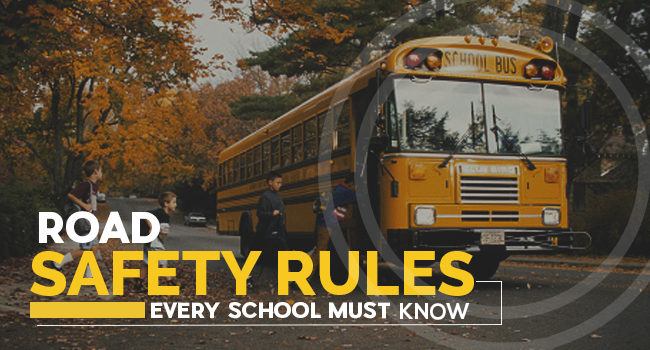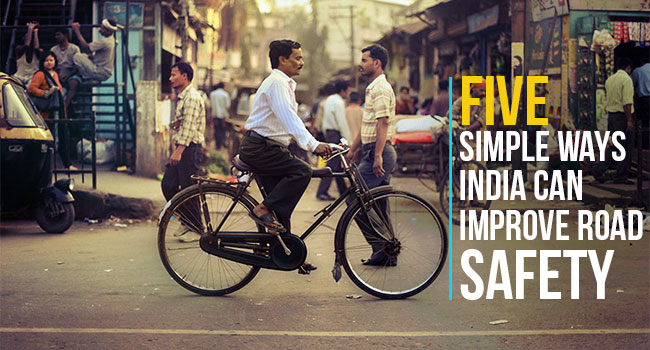Every now and then, we come across new vehicles on the road. Hence, it is vital to know and to follow the basic road safety rules and to ensure that everyone else follow these rules too.
The road safety rules are designed to suit the best interest of the Indian citizens. In a huge country like India, it may be difficult to execute these safety rules; but, it is not impossible.
Here are 30 essential road safety rules to be followed in India:
Read Also: Driving Rules You Need To Follow In The USA
Must Read:
5 Must-know Unwritten Road Safety Rules on Indian Roads
Road Safety Rules for Children (7 to 11 Years Old)
1. Keep Left
Drive adjacent to the left side of the road and let other vehicles in the opposite direction to pass on the right hand side.
2. Turning Left
If you want to turn left, stay close to the left side and then, turn left. After turning, continue to stay to the left side of the road.
3. Turning Right
When you want to turn right, you should first come to the centre of the road carefully and then, turn right keeping your vehicle close to the left side of the road.
4. Passing
Always remember to pass or overtake the vehicle in front of yours from its right side.
5. Passing Prohibited
Overtaking or passing a vehicle and progress in the same direction is prohibited in the following cases:
- If overtaking or passing causes trouble to any other vehicle moving in any direction
- Overtaking is prohibited in a curve as you may not have a clear view of the road ahead and sometimes, it may lead to serious accidents
- It is not wise to overtake or pass if you see the other vehicle’s driver already starting to overtake your vehicle
- If the other driver does not give a signal allowing your vehicle to overtake their vehicle
Read Also: Road Safety Rules In Australia
6. When another Vehicle Overtakes your Vehicle
You should not try to increase your speed or do anything that prevents the other vehicle from passing or overtaking.
7. Intersections
You should be extra cautious while approaching a junction, intersections or a crossing. Make sure that your vehicle does not cause any inconvenience to other vehicles or pedestrians.
8. Right of Way
While approaching an intersection, always give a right of way to vehicles already progressing on that particular road. In other cases, you should proceed only after giving way to vehicles approaching from the right side of the road..
9. Emergency Vehicles
As a road user, it is your responsibility to give way to fire service vehicles and ambulances.
10. Pedestrians
Pedestrians have the right of way at pedestrian crossings or zebra crossings.
Read Also:
Teach Road Safety Rules to Kids with These Interesting Activities
11. “U” Turns
U turns can only be taken when
- there is no warning sign nearby
- you give a proper indication to other vehicle drivers that you are going to take a U turn either by hand signals or vehicle indicators
- you confirm through the mirrors that there is no traffic behind your vehicle
- there is no traffic around your vehicle and take U turn only when it is safe
12. Required Signals
If your vehicle indicators get damaged without any warning, what will you do? At this juncture, hand signals can be really helpful and hence, it is essential for you to learn them. Here are certain situations where hand signs can be used when your vehicle indicator or brakes are not in proper working condition:
- When your vehicle is slowing down
- When your vehicle is preparing to stop
- When you are planning to turn right or overtake a vehicle from the right side
- When you plan to turn left
- When you give permission to the vehicle behind you to overtake your vehicle
13. Indicators
By using mechanical devices or electronic devices, you can simplify the signals for indication.
14. Parking
When you park the vehicle, make sure that it does not cause any hurdle or disturbance to any other road users.
15. Registration
No goods or loads should be kept in a way that hinders the visibility of other vehicles, the headlamps, tail lamps or the vehicle’s registration number. If the vehicle’s registration number is some way tampered, it should be replaced immediately with a duplicate one.
16. One way Roads
In the case of one way roads, try to drive only in the direction indicated on the road signs. Never park your vehicle in reverse on a one way street.
17. Stop Lines
When there are stop lines on the road, ensure that you stop the vehicle behind those lines.
18. Towing
No vehicles should be towed closer to other vehicles on the road. Some of the exceptions are:
- Vehicles that are mechanically disabled
- Partially assembled vehicles
- Registered trailers and sidecars
All these vehicles are allowed to tow for the purpose of delivery, reaching the nearest service station, or garage.
19. Noise
Drivers should not:
- Use the horn in prohibited areas like hospital zones, school zones, etc.
- Use horns that are blaring, irritating, or loud
- Use vehicles that cause a lot of noise when in motion
- Drive vehicles without proper silencers
20. Traffic Lights and Signs
Always obey traffic signs, the instructions given by traffic officials or any other authorized person.
You May Also Like:
10 Important Road Safety Rules to Teach Your Children
21. Following Distance
It is better to keep a safe distance from the vehicle in front of you since there is a chance for the vehicle to stop suddenly. When you keep sufficient distance, you will be able to avoid unnecessary hazards.
22. Right of way on Steep Roads
When the width of the road decreases, it will be difficult for each vehicle to pass at the same time. In such cases, it is always better to stop your vehicle aside and let the other vehicle pass.
23. Obstruction of Control
You should not allow anything that obstructs the view of the road. No one should be permitted to settle, stand, or place anything that hinders his control on the vehicle.
24. Passing Pedestrians
Do not drive your vehicle at a speed of more than 25 km/hr, especially when you pass a procession, meeting, strike, or a march.
25. Tractor and Goods Carriages
It is not allowed to carry passengers on a tractor. Also, drivers of good carriages should not allow more passengers than registered.
26. Loading
It is dangerous to overload vehicle with materials. There should not be anything in the loads that extend towards the front, back or rear side of the vehicle that cause inconvenience to other road users. Also, it should follow the height restrictions decided by the authorities.
27. Dangerous Materials
It is better for a public transport service to not carry explosive, inflammable, or harmful substances as it can be dangerous to them as well as other road users.
28. Driving in Reverse
When you take reverse, you should ensure that it does not cause annoyance to any other people on the road.
29. Essential Documents
A driver should possess the following documents while driving a vehicle: –
a. Driving license
b. Registration certificate of the vehicle
c. Taxation certificate
d. Insurance certificate
e. Fitness certificate
f. Permit
All the above documents should be produced on the demand of a police officer or any authorized person. If the documents are not with them, either the attested copies should be given to the officer directly or sent by post within 15 days.
30. Additional Regulations
In addition to the rules mentioned above, the drivers should be aware about their duties, speed limits, weight limits, signals, etc. Also, they should have an idea about the consequences of driving vehicles without relevant documents, drunken driving etc.
The above mentioned rules can be very much valuable for people of all ages. These rules can make the people safe and secure on the roads. Every year, the number of vehicles on road goes on increasing; so does the importance of road safety. Hence, knowing essential road safety rules can help you and your friends from road related crisis.
To get the PDF version of this blog: Download Here





